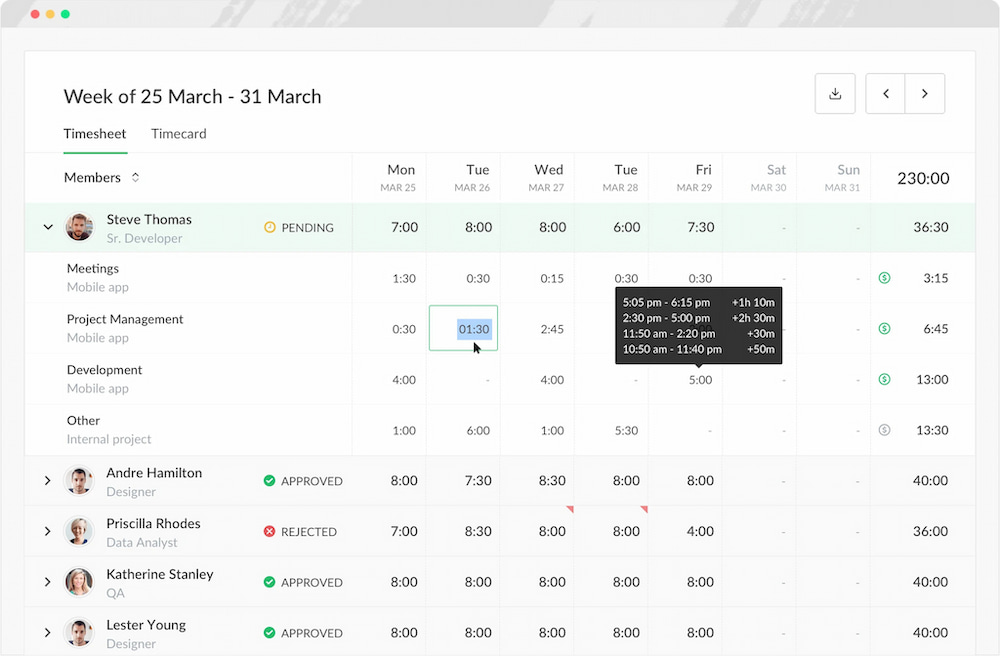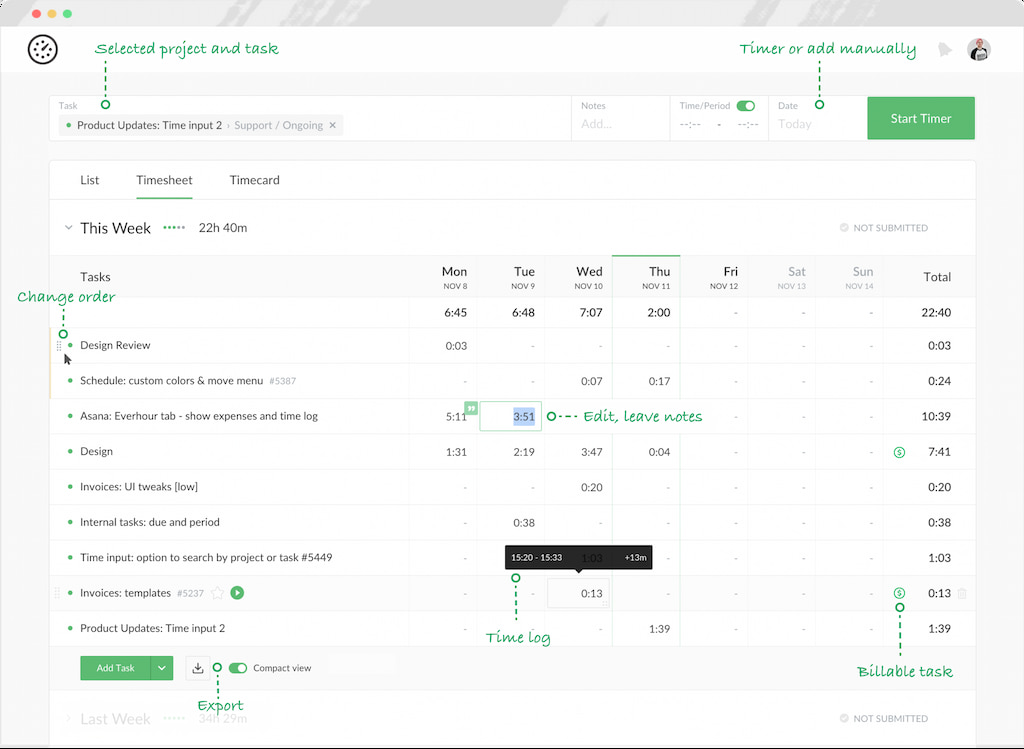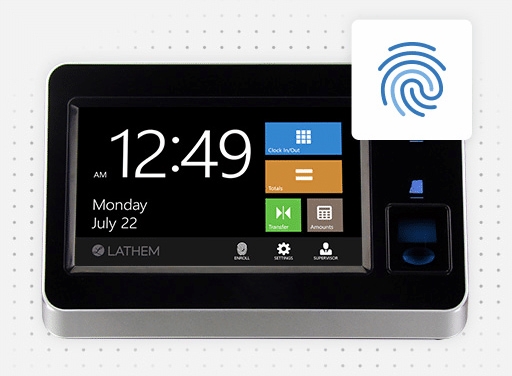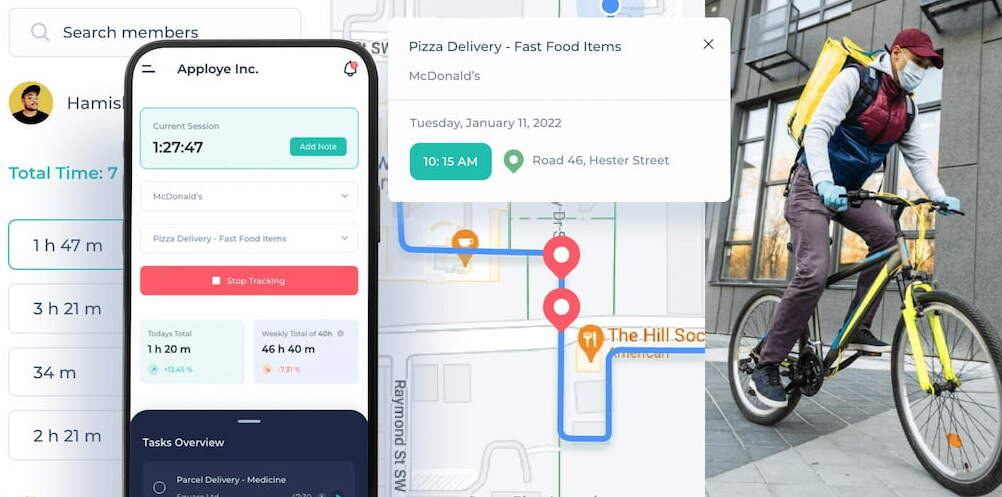The accurate keeping track of employee hours stands as a cornerstone of organizational success. From ensuring fair compensation to optimizing resource allocation, meticulous tracking empowers businesses to navigate the complexities of today’s workforce. In this article, we delve into the diverse methods and cutting-edge tools available to track employee hours effectively. Whether you’re a startup founder or a seasoned HR professional, discover the strategies and solutions on how to track employees hours with the help of the best time management apps and a time tracker to streamline operations and maximize productivity within your team.
Why Tracking Employees Time is Important
Tracking employee hours not only aids in meeting deadlines but also provides valuable insights into resource allocation and productivity. Let’s explore the significance of time tracking and its impact on organizational success.
✍️ Resource allocation: By monitoring how employees spend their time and understanding how to keep track of employees hours, organizations can allocate resources more efficiently.
🚀 Project management: Time tracking provides invaluable insights into project progress and allows managers to identify potential bottlenecks or delays early on.
📈 Productivity measurement: By analyzing time data and tracking employees hours, businesses can identify areas where productivity can be improved and implement strategies to enhance efficiency.
💸 Cost management: Tracking time also helps organizations identify areas of inefficiency and minimize unnecessary costs.
⚖️ Compliance: Time tracking helps organizations ensure compliance with labor laws and regulations, reducing the risk of legal issues or penalties.
📉 Performance evaluation: By analyzing time data, managers can identify top performers, provide targeted feedback, and address any performance issues effectively.
How to Track Employees Hours: Best Way to Keep Track of Employee Time
Manual time tracking
For organizations seeking a straightforward approach how to keep track of employees hours, manual time tracking remains a viable option. This method involves employees recording their work hours manually, typically using timesheets or logbooks. While manual time tracking may seem rudimentary compared to digital solutions, it offers simplicity and flexibility for businesses with basic tracking needs or those operating in environments where digital tools are not feasible.

Key considerations
- Accuracy: While manual time tracking relies on employees’ honesty and diligence, inaccuracies may occur due to human error or forgetfulness.
- Flexibility: Manual tracking allows employees to note breaks, overtime, or non-work-related activities, providing a holistic view of their time allocation.
- Verification: Supervisors or managers may review and verify timesheets for accuracy and compliance with company policies.
While manual time tracking may suffice for small businesses or simple projects, it can be labor-intensive and prone to errors. As organizations grow or require more robust tracking capabilities, transitioning to automated time tracking solutions becomes increasingly beneficial.
Timesheets
Timesheets are a traditional method for tracking employee time and remain prevalent in many workplaces. Here’s what you need to know on how to track employee hours with timesheets.

Key considerations
- Accuracy: Manual entry can lead to errors, so it’s crucial to double-check entries for precision.
- Monitoring: Supervisors must ensure consistent submission and review of timesheets to maintain accuracy and compliance.
- Integration: Timesheet data often needs to integrate seamlessly with payroll and other systems for efficient processing.
While timesheets offer flexibility and familiarity, they require diligent oversight to ensure reliability and accuracy in tracking employee hours.
Time tracking software
Time tracking software is the best way to track employee hours as it represents a transformative tool for businesses, providing unparalleled efficiency and insight into employee activities. Here’s why it’s the optimal solution for modern organizations.
Key considerations
- Automated efficiency: Time tracking software automates the tedious process of manual time entry, saving valuable time and reducing errors associated with traditional methods which can make it the best way to track hours worked.
- Granular visibility: With detailed tracking of hours spent on projects, businesses gain granular visibility into employee productivity, project progress, and resource allocation.
- Data-driven decision making: By leveraging the rich data provided by time tracking software, businesses can make informed decisions regarding project prioritization, resource allocation, and process optimization.
- Compliance and accountability: Time tracking software ensures compliance with labor regulations and promotes accountability among employees, fostering a culture of transparency and responsibility within the organization.
- Enhanced productivity: With real-time tracking and reporting capabilities, time tracking software empowers employees to prioritize tasks effectively, minimize distractions, and focus on high-impact activities.
Optimal solution for modern organizations
Time tracking software emerges as the optimal solution for modern organizations seeking to maximize efficiency, productivity, and profitability. By automating time tracking processes, providing detailed insights, and promoting accountability, it enables businesses to streamline operations, optimize resource utilization, and achieve their goals with precision and agility.
Best way to keep track of employees hours: Everhour
Everhour stands out as a leading time tracking solution with a range of features for hourly employee time tracking tailored to businesses.

Key features
- Precise time tracking: Everhour ensures accurate time tracking through various methods, including manual entry, timer-based tracking, and integrations with project management tools, ensuring precise monitoring of employee hours.
- Seamless integrations: Everhour integrates smoothly with popular project management tools, allowing for seamless time tracking within existing workflows.
- Customizable timesheets: Users can tailor timesheets to their specific needs, enabling flexible tracking and reporting based on project requirements.

- Advanced reporting: Everhour offers robust reporting features, including customizable reports and visual dashboards, providing valuable insights into employee performance and project progress.
- Budgeting: Everhour allows users to set budgets for individual tasks or projects, providing real-time tracking of expenses and ensuring projects stay within budget constraints.

- Time estimates: With Everhour, users can set time estimates for tasks, helping to plan and allocate resources effectively while ensuring deadlines are met.
- Project analytics: Everhour offers robust project analytics, including insights into project progress, resource allocation, and team performance. Users can generate customizable reports to gain valuable insights and make data-driven decisions.
Pricing
- Free
- Team plan: $8.50 per user per month
What makes Everhour great for time tracking
All of the features above make Everhour the best way to track employee time. Everhour excels in simplifying time tracking processes with its intuitive interface, customizable features, and seamless integrations. Its advanced reporting capabilities and precise time tracking functionalities make it an ideal solution for businesses seeking to enhance productivity and efficiency through effective time management.
Traditional time clocks
Traditional time clocks have long been a staple for businesses seeking a reliable and straightforward method on how to track employees time. Despite the advent of digital solutions, traditional time clocks remain a popular choice for many organizations due to their simplicity and ease of use.
Key considerations
- Ease of use: Traditional time clocks are user-friendly devices that require minimal training to operate. Employees can easily clock in and out using a physical time card or biometric scanner, eliminating the need for complex software interfaces.
- Accuracy: While traditional time clocks may lack the advanced features of digital solutions, they offer reliable and accurate time-tracking capabilities. Employees can punch in and out with precision, providing accurate records of their work hours.
- Cost-effectiveness: Traditional time clocks are often more affordable than digital alternatives, making them an attractive option for small businesses and organizations with limited budgets. Additionally, they require minimal ongoing maintenance, further reducing operational costs.
While digital time-tracking solutions offer advanced features and automation capabilities, traditional time clocks remain a viable option for businesses seeking a straightforward and cost-effective method of tracking employee hours. With their ease of use, accuracy, and affordability, traditional time clocks continue to play a valuable role in the realm of time tracking.
Biometric time clocks
Biometric time clocks represent a cutting-edge solution for businesses seeking advanced time tracking capabilities combined with personalized security features. These innovative devices leverage biometric technology to accurately record employee hours while ensuring only authorized personnel can access sensitive data.

Key considerations
- Enhanced security: Biometric time clocks use unique biological traits such as fingerprints, facial recognition, or iris scans to verify employee identities. This personalized authentication method significantly reduces the risk of unauthorized access and prevents time theft or buddy punching.
- Accurate time tracking: By eliminating the need for manual time cards or PIN codes, biometric time clocks provide more accurate and reliable time tracking data. Employees simply scan their biometric identifiers to clock in and out, reducing errors and discrepancies in recorded hours.
- Streamlined processes: Biometric time clocks streamline time tracking processes by automating attendance management and payroll calculations. With real-time data capture and integration with payroll systems, businesses can improve efficiency and reduce administrative overhead.
Biometric time clocks offer a sophisticated solution for businesses looking to enhance time tracking accuracy and security. By leveraging biometric technology, these advanced devices provide personalized authentication, accurate time tracking, and streamlined processes, ultimately contributing to improved productivity and compliance with labor regulations.
GPS-based time tracking
In an increasingly mobile work environment, GPS-based time tracking has emerged as a powerful tool that teaches how to track employee time and attendance and ensures accountability, particularly for remote or field-based teams. By leveraging GPS technology, organizations can accurately track employee locations and work hours, enhancing operational efficiency and transparency.

Key considerations
- Location verification: GPS-based time tracking systems use satellite technology to pinpoint employee locations when clocking in or out. This feature provides employers with real-time verification of employee whereabouts, ensuring that work is performed at designated locations.
- Remote work monitoring: For remote or mobile employees, GPS-based time tracking enables employers to monitor work hours and activities outside of traditional office settings. This capability is especially valuable for industries such as construction, transportation, or sales, where employees operate in diverse locations.
- Geofencing capabilities: When employees enter or leave these predefined zones, the system automatically records their time, providing accurate data for payroll and project management purposes.
GPS-based time tracking systems offer a reliable solution for businesses seeking to enhance accountability, efficiency, and compliance with labor regulations. By leveraging GPS technology, organizations can accurately monitor employee locations, streamline time tracking processes, and ensure optimal resource allocation, ultimately contributing to improved productivity and operational effectiveness.
FAQs: Tracking Employee Hours
Q: Why is tracking employee hours important?
A: Tracking employee hours is essential for several reasons. It helps businesses monitor productivity, ensure accurate payroll processing, comply with labor regulations, and optimize resource allocation.
Q: What are the different methods for tracking employee hours?
A: There are various methods for tracking employee hours, including manual timesheets, time clock systems, biometric scanners, GPS-based tracking, and time tracking software.
Q: What is the best method for tracking employee hours?
A: The best method depends on the specific needs and preferences of the organization. Time tracking software is often favored for its accuracy, efficiency, and flexibility, allowing businesses to track hours across different devices and locations seamlessly.
Q: How can time tracking software benefit businesses?
A: Time tracking software offers numerous benefits, including improved accuracy in time tracking, streamlined payroll processing, enhanced productivity monitoring, detailed reporting and analytics, and seamless integration with other business tools and systems.
Q: How do GPS-based time tracking systems work?
A: GPS-based time tracking systems use satellite technology to track employee locations and movements. Employees typically use mobile devices or dedicated hardware with GPS capabilities to clock in and out, allowing employers to monitor their whereabouts in real-time.
Q: Are there any privacy concerns associated with GPS-based time tracking?
A: While GPS-based time tracking provides valuable location data for employers, it also raises privacy concerns for employees. To address these concerns, businesses should establish clear policies regarding the use of GPS tracking, obtain consent from employees, and ensure compliance with relevant privacy regulations.
Q: What features should I look for in a time tracking software?
A: When choosing a time tracking software, consider features such as customizable timesheets, automated time tracking, reporting and analytics, integrations with other software tools, mobile accessibility, and user-friendly interface.
Q: How can I ensure accurate time tracking for remote employees?
A: To ensure accurate time tracking for remote employees, consider using time tracking software with built-in features for remote work monitoring, such as screenshot capture, activity tracking, and task tracking. Additionally, establish clear guidelines and expectations for remote work and provide training on how to use the time tracking tools effectively.
Best Tips for Tracking Employee Hours
Knowing how to keep track of employee hours and tracking employee hours effectively is essential for maintaining productivity, managing resources efficiently, and ensuring accurate payroll processing. Here are some best practices to help you track employee hours effectively:
❗ Utilize time tracking software
Invest in reliable time tracking software that offers features such as automated time tracking, customizable timesheets, reporting and analytics, and mobile accessibility. Time tracking software streamlines the process of tracking employee hours, improves accuracy, and provides valuable insights into productivity.
❗ Establish clear policies and procedures
Develop clear policies and procedures for time tracking, including guidelines for clocking in and out, recording breaks and meal times, and submitting timesheets. Communicate these policies to employees and ensure they understand their responsibilities regarding time tracking.
❗ Provide training and support
Offer training and support to employees on how to use time tracking tools effectively. Provide demonstrations, tutorials, and resources to help employees navigate the software, input their hours accurately, and resolve any issues or questions they may have.
❗ Set expectations for remote work
If you have remote employees, establish clear expectations for time tracking and remote work monitoring. Define expectations for availability, communication, and productivity, and provide guidelines on how to track time accurately while working remotely.
❗ Regularly monitor and review time data
Regularly monitor and review time tracking data to identify trends, patterns, and areas for improvement. Use reporting and analytics features to analyze employee hours, track project progress, and identify opportunities to optimize resource allocation and productivity.
❗ Encourage transparency and accountability
Foster a culture of transparency and accountability around time tracking. Encourage employees to track their time accurately, report any discrepancies or issues promptly, and take ownership of their time management.
❗ Address compliance and legal requirements
Ensure compliance with labor laws, regulations, and industry standards related to time tracking, overtime pay, and employee breaks. Stay informed about changes in labor regulations and adjust your time tracking policies and procedures accordingly.
❗ Regularly communicate with employees
Keep lines of communication open with employees regarding time tracking policies, procedures, and expectations. Address any concerns or questions they may have, and solicit feedback on the time tracking process to identify areas for improvement.
How to Track Employees Hours: Conclusion
Tracking employee hours is important for staying productive, paying people correctly, and following labor laws.
Using tools like Everhour and smart time management strategies helps businesses work better. With accurate time tracking, teams can stay on schedule, avoid burnout, and get more done — leading to better results all around.
If you are managing a team of 5 or more and looking to boost efficiency, Everhour is the perfect tool to keep your team on track. It’s also an excellent fit for creative teams, making Everhour a go-to solution for time tracking for designers.
Check out our article on how to write an employee attendance record in Excel!
Discover the true cost of untracked time in project-based businesses — and learn how to stop revenue from slipping through the cracks.

